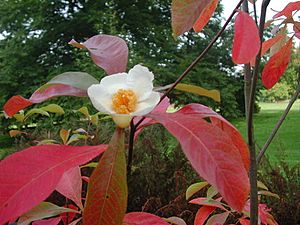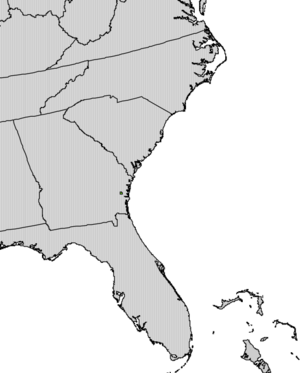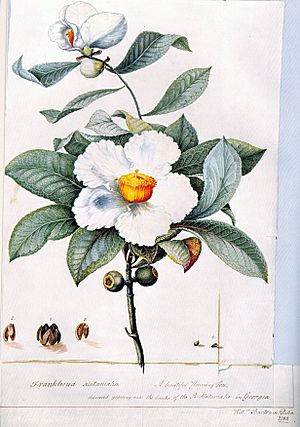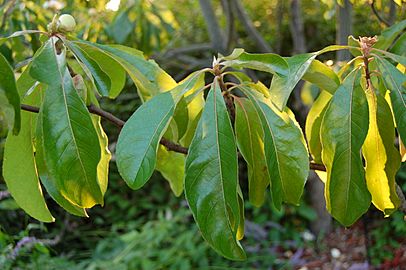Franklin tree facts for kids
Quick facts for kids Franklin tree |
|
|---|---|
 |
|
| Flower and leaves in autumn | |
| Conservation status | |
| Scientific classification | |
| Genus: |
Franklinia
|
| Species: |
alatamaha
|
 |
|
| Natural range | |
| Synonyms | |
|
|
The Franklinia is a special type of plant in the tea family, called Theaceae. There is only one species in this group, a beautiful flowering tree known as Franklinia alatamaha. People often call it the Franklin tree.
This tree used to grow naturally in the Altamaha River valley in Georgia, in the southeastern United States. However, it has been extinct in the wild since the early 1800s. Luckily, it still survives today because people grow it in gardens and parks as an ornamental tree.
Scientists once thought the Franklin tree was closely related to another plant called Gordonia. But later studies, including DNA tests, showed that Franklinia is actually more closely related to an Asian plant group called Schima.
Contents
What the Franklin Tree Looks Like
The Franklinia alatamaha is a small deciduous tree. This means it loses its leaves in the fall. It can grow up to 10 m (33 ft) (about 33 feet) tall, but it's usually around 4.5–7.5 m (15–25 ft) (15 to 25 feet) tall.
Flowers and Leaves
People love this tree for its sweet-smelling white flowers. They look a lot like single white Camellia blossoms. Some people say the smell reminds them of orange blossoms or honeysuckle.
The tree has a neat, pyramid shape. Its bark is gray with white stripes and feels bumpy. The leaves are about 6 in (15 cm) long and turn a bright orange-red in the fall, making the tree look stunning.
Unique Seed Capsules
The seeds of the Franklin tree grow inside special round capsules. What's really interesting is that these capsules take a very long time to ripen – about 12 to 14 months!
Most plants start growing their seeds right after they are pollinated. But the Franklin tree is different. It gets pollinated in late summer or early fall, then the tiny seed inside goes to sleep for the whole winter. It only starts to grow and develop the following summer. This "winter sleep" for the seed is very rare for plants in places with cold winters. When the capsules are ready, they split open in a unique way to release the seeds.
History of the Franklin Tree
The Franklin tree was first discovered by two botanists, John and William Bartram, from Philadelphia. They saw it growing along the Altamaha River in Georgia in October 1765.
William Bartram went back to the same spot several times. In 1777, he managed to collect some of the tree's seeds. He brought them back to Philadelphia and planted them at his family's garden, Bartram's Garden.
After studying the plant for several years, William Bartram decided it was a new type of tree. He named it Franklinia alatamaha in honor of his father's good friend, Benjamin Franklin. The name was first shared with the public in 1785.
Why It Disappeared from the Wild
William Bartram was the first to notice that the Franklin tree only grew in one very small area. He said he never saw it anywhere else, which was "very singular and unaccountable."
The last time the tree was definitely seen in the wild was in 1803. We don't know exactly why it disappeared from its natural home. Some ideas include:
- Forest fires
- Flooding
- Too many plant collectors taking seeds and plants
- A plant disease that might have spread from cotton farms nearby.
Today, every Franklin tree alive in the world comes from the seeds William Bartram collected and grew at Bartram's Garden. These trees are now grown in over 1000 places around the world, including botanical gardens, parks, and even people's backyards.
Growing the Franklin Tree
Gardeners sometimes find the Franklin tree a bit tricky to grow, especially in cities. It likes sandy soil that is a bit acidic. It doesn't do well in heavy clay soil, or if its roots get too wet or are disturbed a lot.
The Franklin tree doesn't have many known insect pests. However, it can get root rot or crown rot, which are diseases that affect its roots and lower trunk. It also doesn't like long dry periods without water. If you want to grow one, you can usually buy them from plant nurseries.
Gallery
See also
 In Spanish: Franklinia para niños
In Spanish: Franklinia para niños








